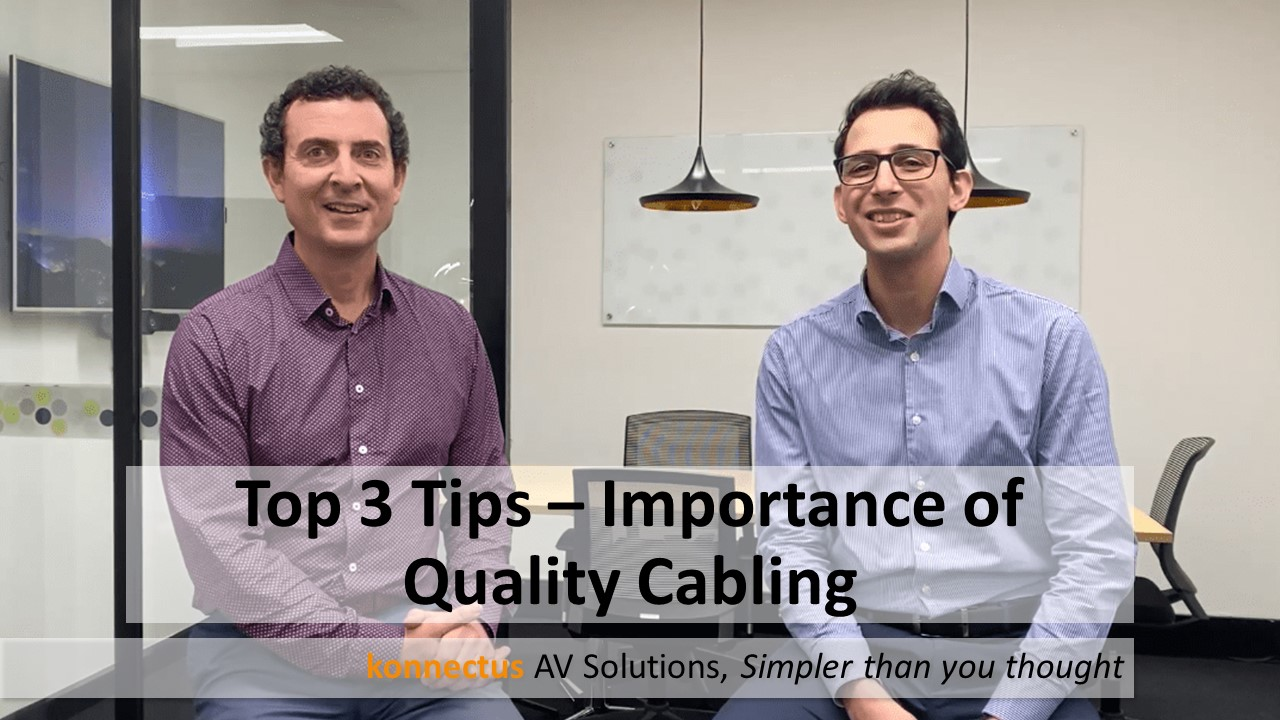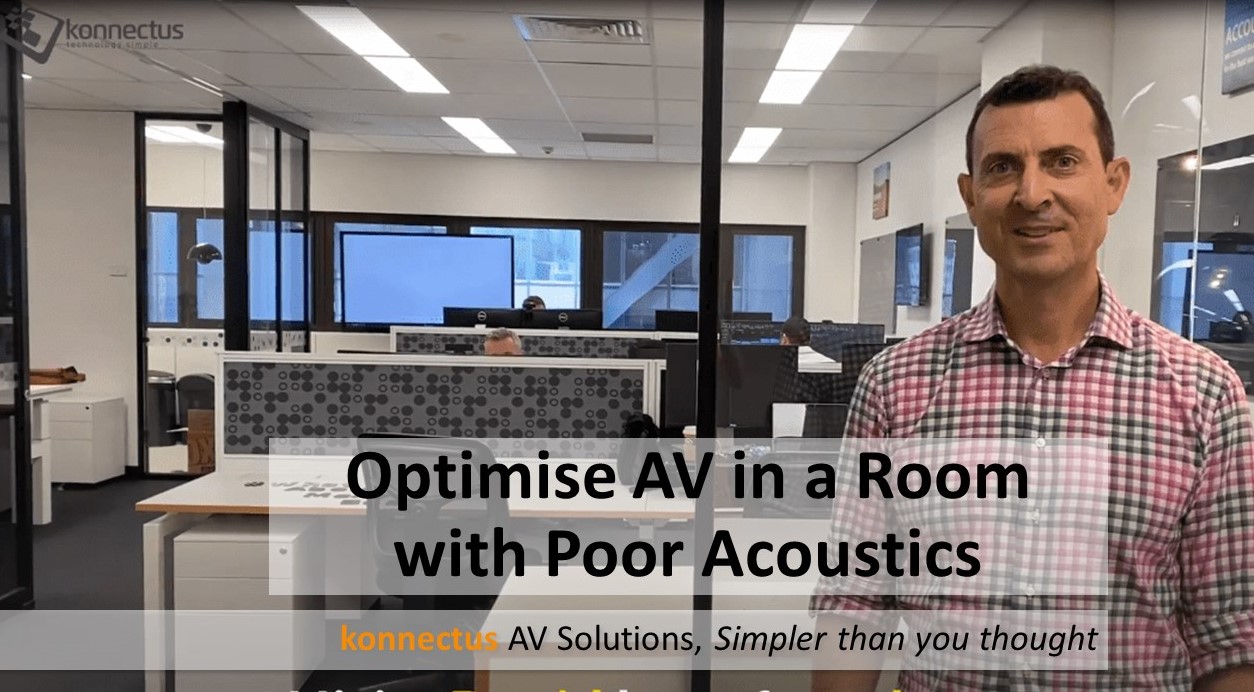You all want your AV systems to be as reliable as possible. Aside from great design, the quality of installation is key to achieving this goal. One way to align the expectations of the designer, installer, and client is to document desired outcomes using short videos. Watch this short video to see how you can apply this concept to communicate the testing and commissioning procedures on your next project. I guarantee it will help you achieve consistency and reliability across your AV systems.
Top 3 Tips – Importance of Quality Cabling
So, Jonathan, let’s talk a little bit about cabling. It’s often overlooked, I think, in AV projects, but it’s very important. So, I’ll tell you a story about what happened this week in one of our major projects. We obviously went to a great deal of effort and time to specify particular cabling for the customer in the project, and it’s of a very high standard and quality. However, the installation company maybe didn’t pay attention and put in a lesser grade quality of cable, which is unfortunate because now that cabling is going to have to be removed and replaced with the right cabling, which is time and money and not a great result for the project. So, I thought, you know, based on that experience it might be a good idea, just to share maybe the Top Three reasons why choosing the right quality of cable for the application is so important. So, what would be the First Tip or reason you might have? Yeah, so look when I think of the cabling it really is such a critical part of an audio visual or technology system. And the analogy I like to use is one of a road. So, imagine we’ve got a Ferrari, we’ve purchased some great equipment on either end of the road. We’ve got a perfect car. It’s beautiful. It can go really fast. Now, if we put that Ferrari on a nice motorway. It’s nice and smooth and we can really make use of that Ferrari and the capabilities. Same with a technology system. Now, if that road had potholes, or it was one lane, or had a lot of traffic at traffic lights on it. All of a sudden, even though you’ve purchased a fantastic car, you’re not actually able to make use of it because of the poor quality of the road. Now, exactly the same thing can be said for cables as well. I can have great displays. I can have great sources. But if that cable, that road, is not high quality, then I’m not actually making use of my systems that I have paid so much money for. So, the integrity of the signal gets compromised and degraded somewhat, which is not a good result. Absolutely! Then there’s the installing of the cable as well. So, there’s two other factors. Yes, I’ve selected the right type of cable. You know, I’m going to build a motorway, but now we’ve to think about how to install it. We want to try and make it straight and without any breaks. Okay so no traffic lights stopping along the way. Perfect! And the other one is when we physically install it is we want to make sure we adhere to all of the manufacturer’s requirements so that we can get the maximum performance. Now imagine laying the road. You poured the right tarmac, but you haven’t installed it correctly, and now it’s all deformed with those potholes. Same thing can be said for installing cables. So that’s why we need to make sure we terminate, maintain bend radius and install it as per the manufacturer’s instructions. And just going back to the breaks in the chain concept. That’s also a design related aspect, isn’t it? You want to have that integrity of signal and reduce the breaks in the chain as much as possible because even little terminations, even if they’re terminated correctly and installed correctly, it’s still potential signal loss or degradation, which compromises the ultimate image or your sound that you’re hearing or control signal. That’s right. It’s an opportunity to leak. Perfect! Alright thanks, Jonathan. Hopefully, viewers find that useful. If you’d like to know a bit more information, maybe at a technical level, feel free to reach out to especially Jonathan here at konnectus. Thanks for watching.
QSC Camera Preview in Microsoft Teams Room Systems
In the new hybrid workspace, how can you improve the conference call experience and make it equally engaging for both remote workers and in room meeting participants? This question is top of mind for many of the customers we are working with in 2021. Using multiple cameras in a meeting space is one way to improve the experience for all parties and QSC have released a simple to use solution. Imagine a room with a main camera and a whiteboard camera that can be easily previewed and controlled during a Microsoft Teams call. Check out this video from Jonathan Cuthbertson of konnectus for all the details.
New Camera Control Feature in Crestron Flex Systems
We are starting to get some great feedback from end users at our customers as they get back to the office and start using their newly installed Microsoft Teams Rooms systems. One feature that people seem to really love or really dislike is the automatic tracking or framing of the in-room cameras. Luckily, Crestron, Logitech, and Huddly have worked together to provide an option for people to turn this feature off when desired. Freedom of choice is a great thing for end users, I think.
Watch this video from Jonathan Cuthbertson of konnectus for all the details.
Optimise Your AV in a Room with Poor Acoustics
How many times have you been in a meeting space or classroom and really struggled to clearly hear what is being said? Whether there is an AV system in use or not, this can be a frustrating experience that you can no doubt relate to.
I often get asked whether a high quality AV system in the room can improve the listening experience – especially on conference calls. In this video you’ll learn how you can achieve a high quality listening experience in any room. I share an example of a recent customer we worked with and the steps we followed to solve such a problem.
Stem Audio – Review | Does It Live Up To The Hype
The Stem Audio Ecosystem is comprised of five device categories: Ceiling mount, Wall mount, Table mount, Hub and Control. It’s an ambitious product line that attempts to simplify the deployment of high-quality video conferencing audio systems for a range of different room types and sizes. In this short product review, we reveal some of the key discoveries during our hands-on time with the ecosystem and its components.





